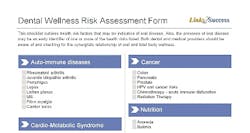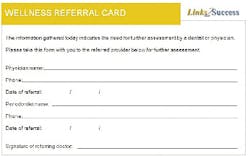Thinking like an oral physician makes $ense
Christine Taxin, Adjunct Professor New York University Dental School
Links2Success.com
Studies show that up to 50% of heart attacks are triggered by oral bacteria.1 Others have demonstrated links between oral bacteria and diabetes,2 high blood pressure,3 dementia,4 autoimmune diseases,5 preterm labor, miscarriage, and infertility,6 among other serious systemic complications. Not surprisingly, the dental community is acting on the research by providing preventive services, such as oral cancer screening, CT scans, and saliva testing - definitive movement integrating the mouth and body. As more dentists integrate systemic disease risk assessment and offer patients medical insurance reimbursement for certain dental procedures, some experts in the field are rethinking the job description of modern dentists.
A recent article published in theJournal of Primary Preventionpredicts the future of dentistry will look different than it does today. Because of a shortage of primary care providers in the U.S., and the fact that dentists are already skilled in the assessment of many systemic diseases, the article suggests dentists should be allowed to broaden their scope of work from "provision and supervision of dental care to the provision of limited preventive primary care."7 The article makes a strong case to change the official title of dentist to oral physician. As Dr. Donald Giddon, DDS, PhD, states, "The 'oral physician' is a term that best describes what we do. The word 'dentist' refers only to teeth, and what we do with [regard] to screening for chronic disease goes far beyond the teeth."8 The vision is one where dentists would fill the void of primary care providers, being able to offer select services that would have great impact on the health of the nation.
However, there are barriers to the acceptance of the shift. A primary concern is the "reimbursement hurdle," whereby dentists as oral physicians would be reimbursed for their services. Another concern is there is not currently a solid business plan that can provide dentists with a path to profitability and better care. On the other hand, there are multiple supporting factors that researchers believe offer hope.
1. Public and private insurers endorse the concept of the patient-centered "medical home."
2. The successful integration of midlevel dental therapists conducting procedures under the care of an oral physician in dental offices, nursing homes, hospitals, and schools allows the doctor to focus on things outside the scope of the midlevel provider.
3. Changes in pre- and postdoctoral dental education that may increase training of dentists as oral physicians.
4. The Affordable Care Act includes several new funding streams for the education of general dentists to potentially receive training as oral physicians.9
While the formal shift in defining dentists as oral physicians may be a few years away, many dentists are already beginning to think like oral physicians and are seeing positive results both clinically and financially. These doctors are shifting from restoration-centered dental offices to prevention-centered wellness centers.
Wellness centers: Building the infrastructure
While experts are still working on a formal business plan that incorporates midlevel providers and an official title change (and scope of work) for dentists, a major benefit of the wellness center is that preventive and medical-minded infrastructures and systems are being built. The wellness center may be the best place to see if a larger expansion could work, and to answer the question - does it pay for dental teams to take on more preventive care? While there is no one-size-fits-all definition of a dental wellness center, they do exhibit four defining characteristics (Fig. 1):
1. The team recognizes patients as experts and comanagers of their health.
2. The office has a capacity to address conditions that cause a loss of function (i.e., sleep apnea, TMD, periodontal disease).
3. The team has prioritized risk assessment and prevention of disease.
4. The office has the capacity and training to bill a patient's medical and/or dental insurance.
FIG. 1
Wellness center teams are bridging the gap between the medical and dental disciplines as well as paving the way for an expansion of preventive services. Currently, wellness center protocols exist in cross-discipline risk assessment and referral tools (Figs. 2 and 3). They use electronic medical records that allow the dental team and primary care physician to have the most accurate medical and dental histories, drug profiles and interactions, and laboratory results, which vastly improve patient safety and treatment effectiveness. Wellness center teams are also trained and actively cross-code medical insurance for reimbursement, which has led to increased treatment acceptance and better patient health, and is a key indication that there is financial benefit to thinking like an oral physician.
FIG. 2
FIG. 3
Thinking like an oral physician makes $ense
The financial benefits seen in the wellness center are largely due to the staff being able to cross-code for reimbursement of procedures deemed medically necessary. Thinking like an oral physician generates case acceptance for large procedures because billing medical insurance can leave dental benefits available for nonmedical procedures. According to an article by Jay Wood, "This advantage cannot be overstated when you consider that an average dental plan may only pay $1,500 in dental benefits, which can easily be consumed in a single root canal or crown."10
Dental teams can also save patients money on large procedures they may not have accepted otherwise, benefitting the bottom line as well as patients' health. Mr. Wood says, "Typically dental plans will cover 50% of the procedural costs. Most medical plans offer more generous copays, with 80% of reasonable and customary charges being common. When you can offer patients that level of savings on major procedures, they are more likely to make medically sensible decisions, and they are also likely to have greater loyalty to a dental practice that, in their eyes, offers more affordable care."11
The medically necessary procedures that can be billed to medical insurance include:
· Oral surgical procedures
· Medically necessary implant procedures
· Medically necessary periodontal procedures
· Consultations and examinations for orofacial medical conditions
· TMJ procedures
· Dental procedures related to trauma
· Screenings for oral cancer
· Sleep apnea procedures
· X-rays, including medically necessary CT scans associated with the procedures above12
On a larger scale, thinking like an oral physician may curb the excessive costs to states that are spending millions to treat preventable dental cases in emergency rooms. One study states, "In Florida, dental-related emergency hospital visits produced charges exceeding $88 million in 2010. States are saddled with some of these expenses through Medicaid and other public programs." The study concluded with, "States can reduce hospital visits, strengthen oral health, and reduce their costs by making modest investments to improve access to preventive care."13 Researchers also suggest a cost-saving solution: "Improved relationships between medical and dental providers [as they] could help address dental needs before patients end up seeking care in emergency rooms."14 Dental teams adopting the wellness center model are making these changes in philosophy and protocols now.
First-hand signs of success
Many offices have first-hand reports about the benefits of thinking like oral physicians. One example from Seattle, Washington, describes a patient who suffered from debilitating periodontal disease, was unable to chew or swallow, and was also diabetic. Working with her endocrinologist, the dentist secured medical reimbursement for bone grafts, implants, and overdentures, and the medical reimbursement exceeded $13,000. Another doctor who treats sleep apnea has every single case he treats reimbursed by patients' medical insurance. Thinking like an oral physician not only allows dentists to provide excellent care, it also helps patients afford the care they need to treat their oral illnesses.
In summary
The chasm between the medical and dental fields is slowly closing. One vision for the future transforms dentists into oral physicians who are permitted to expand preventive care access to patients. In the meantime, there is phenomenal work taking place by doctors who, within the current structure of dentistry, are beginning tothink like oral physicians. They are collaborating with medical doctors and billing medical insurance, thereby better serving patients and successfully paving the way for the future of the profession.
References
1. Bacterial signatures in thrombus aspirates of patients with myocardial infarction. Circulation. 2013, March 19; 127(11): 1219-28.
2. Efficacy of periodontal treatment on glycemic control in diabetic patients. Diabetes Metabolism 2008, Nov;34(5) 497-506.
3. Periodontal bacteria and hypertension (INVEST). Journal of Hypertension 2010, 28: 1413-1421.
4. Serum antibodies to periodontal pathogens are a risk factor for Alzheimer's disease. Alzheimer's Dement. 2012 May; 8(3): 196-203.
5. Periodontal therapy reduces the severity of active rheumatoid arthritis in patients treated with or without tumor necrosis factor inhibitors. Journal of Periodontology, 2009, Vol. 80, No.4, 535-540.
6. Maternal periodontal disease and preterm or extreme preterm birth. Journal of Periodontology. 2010 Mar; 81(3): 350-358.
7. http://www.ncbi.nlm.nih.gov/pubmed/23728907
8. Dr. D. Giddon, personal communication, July 10, 2014
9. http://www.ncbi.nlm.nih.gov/pubmed/23728907
10. http://www.dentrix.com/articles/content.aspx?id=303
11. http://www.dentrix.com/articles/content.aspx?id=303
12. http://www.dentrix.com/articles/content.aspx?id=303
13. http://www.pewtrusts.org/en/about/news-room/press-releases/0001/01/01/more-americans-turning-to-costly-hospital-care-for-preventable-dental-problems
14. http://healthjournalism.org/blog/2014/04/lack-of-access-to-dental-care-leads-to-expensive-emergency-room-care/
Christine Taxin is the founder and president of Links2Success, which delivers continuing education seminars for dental and medical professionals. She serves as an adjunct professor at the New York University (NYU) Dental School and Resident Programs. As a CE provider, Ms. Taxin has been a guest speaker at numerous dental meetings, including Greater New York two years in a row. The AGD has approved Links2Success as a national provider of PACE continuing education credits. Ms. Taxin's new book "Codelyology," is the first of its kind within the dental industry.



